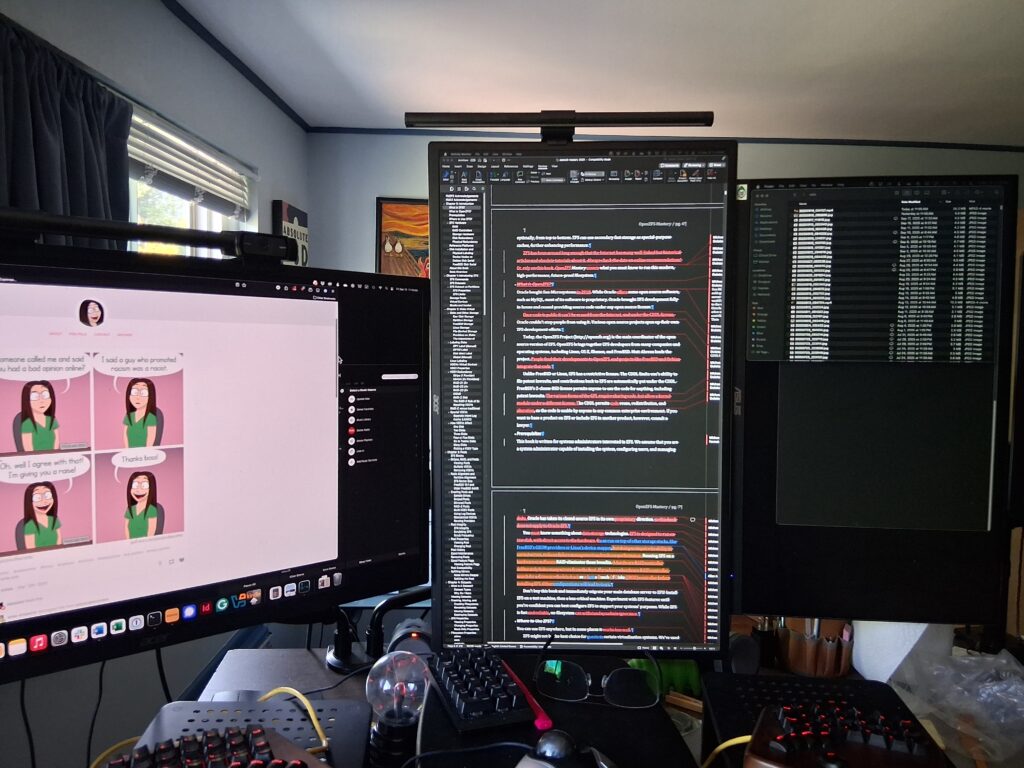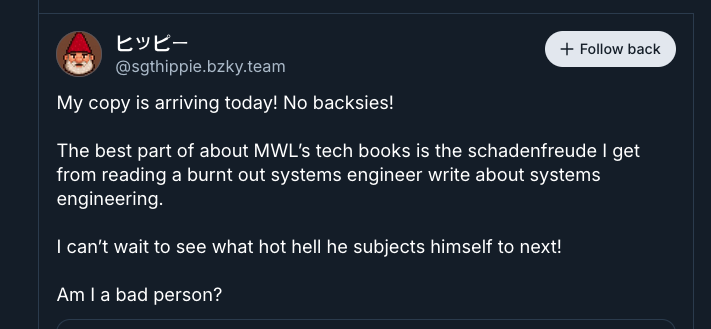This post goes to Patronizers in November and becomes public in December. Not a Patronizer? You could be! $12 a year gets you my latest updates, occasional free tidbits, and the completely pointless MWL Footnote Fortune File, freshly updated for the new edition of Networking for System Administrators.
Last month got home from EuroBSDCon and made it a point to post the monthly column my first day back. #ebc25 was great. Meticulously run. Fantastic program. Great food. The local staff kicked butt. I brought home a tie that I shall treasure but hopefully never need, stoopwaffel, joyful memories, and covid.
About an hour after I posted last month’s StSbM, the fever hit.
There’s nothing quite like publishing a book while hallucinating. So I didn’t. It delayed N4SA2e by a couple weeks, but that’s better than releasing delerium-infused work (shut up shut up shut up). It took me down for a couple weeks, but the book is now finished and at the printer. Let me check… yep, they now show up as “printing.” Should be here in a couple weeks. I have fresh envelopes and printable labels ready and a good pen to sign them all. The sponsor mailing addresses have been validated and a giant postage spreadsheet assembled.
Once the books ship, I will tell the Kickstarter folks that they have two days to finalize their addresses.
I’m still not completely recovered. My attempts to make words on OpenZFS Mastery prove that.
The ugly truth is, every time I attend an event that doesn’t have a mask policy, I get sick. I wear a mask throughout. Masks work, but crowded closed-in rooms overwhelm their protections. Everyone needs to contribute to protecting the community.
I will no longer attend any conference that doesn’t require masks. Yes, both Penguicon and BSDCan have dropped their mask policies. I won’t be at either. Cons are fun and educational, and I enjoy meeting colleagues and readers, but I’m old enough that I must prioritize my health. Can’t write books if covid fries my brain, and while I’ve reached my final form, said form is utterly unemployable.
But we do have a manuscript for OpenZFS Mastery! Well, pieces of it. It’s basically the first edition FreeBSD ZFS books slammed together, along with copious notes from Allan and myself on what needs to be changed. It’s essentially a skeleton that we need to add flesh to. Covering Debian as well as FreeBSD means restructuring most of the book. Here’s one page of the introduction, with the changes in red.

That photo’s a few weeks old, before Allan took a look. More has changed since then.
The one thing that remains unchanged from those old books and the new? My test host. Almost twelve years ago, I bought a ten-drive amd64 server. One of the power supplies has blown, but the rest works just fine. 32GB of RAM and eight cores is more than sufficient, and I can have mirrored boot drives while striping two RAIDZ2 arrays.
One of NYCBug’s fine folks shipped me a “high-end” custom-built, undocumented dual storage array that I haven’t had time to set up yet. My career has many gaps, but one of them is custom storage. I’ve used external storage arrays, sure, but I ordered them as complete kits. They included all the cables. This thing doesn’t. If I still had a day job, I’d go to the boss and tell them that the kit is incomplete and here’s my best guess for the cables and if they’re wrong, too bad, I didn’t choose this stuff. I’d happily let the boss spend a few grand on cables to try. But this will let me write a better book, so I gotta figure it out.
The smart thing to do is write a blog post with descriptions and photos, and ask my social media followers for advice. One of them must be a storage guru, or at least familiar with the ARC1330-8X/8I/8X8I/4x4I and Adaptec AEC-82885T in these things.
But the important thing right now is making words. And the ten-drive host is good enough for that. I’ve been working with bhyve and getting test hosts running.
It’s my first time playing with bhyve. It’s powerful, but like BSD has less of a “learning curve” and more of a “learning curb.” I’ve been watching it for a while, though. Back around 2018 (or some year like that), I asked Michael Dexter if it was time to write a bhyve book. He told me that things were churning rapidly and I should probably wait. EuroBSDCon included a one-day bhyve con, chaired by Dexter. I went. During the pre-lunch lightning talks, he requested that I come up to the front and then asked me why “we” didn’t have a bhyve book yet and what it would take to get one. I gave him a quite meaningful glare. “Well, last time I asked someone said…”
Anyway. Bhyve is cool. It’s stable enough that Kirk McKusick uses it for filesystem development. I’m using vm-bhyve as a front end, because raw bhyve requires long command lines and I’m lazy. Will there be a bhyve book? Ask the winds of karma because I got no clue. I know that after OpenZFS Mastery my next tech book will be on DNS. I don’t want to write a DNS book. The world needs an approachable DNS book the way it needed the mail book, though. Otherwise the oligarchy wins without a shot fired, and I’m an absolute sucker for horrific heroic last stands.
I can say that I’m taking the notes I would need to write a bhyve book, though. Why would I even consider writing a bhyve book when I haven’t used bhyve?
Because that’s the correct way to write a book about any technical topic.
Writing a tech book (or, indeed, any book) is not about documenting facts. Man pages and source code have all the facts, and when someone declares “it’s in the man page” folks rightfully flip out. Facts are not knowledge. Books are not about the facts; they are about the connections between facts. I watch my brain while I’m learning. The moments of enlightenment, when I realize how pieces fit together? That’s treasure. It goes into the notes. Those moments become the backbone of the book.
It’s also true for fiction. Laserblasted was written as a joke, and I’m told it came out funny, but look at this daft lump of the first chapter.
The Greys invented police long before humans did. One of the things they police is access to humans. It’s not that they care about us. Humanity hasn’t evolved enough to join the galactic market and hasn’t invented antigrav so the Galactic Species Index classifies us as livestock. If someone figures out how to profitably strip-mine us before we get our act together, we’re done. While the Orion’s Sword civilizations consider human pineal glands a potent aphrodisiac, we’ve put so many toxic chemicals into our environment that the Swordian Morality League has taken to saying, “take gland for your last stand.” The Greys put humanity on the Protected Species list, which isn’t so much for our benefit as giving them another excuse to put the boot in. The Swordian Society for Responsible Human Ranching will get that law changed one day and swoop in to save us from ourselves, for them.
Pick any one of these very stupid sentences. I can draw a line from it to the characters, the story, and the resolution thereof. (I still can’t believe that daft thing funded. At least it’s a complete commercial failure in the retail market, showing there might be hope for civilization and good taste.) Even stupidity is pointless unless it’s tied up in an ordered bundle of stupidity.
Anyway: everything is about connections. Not facts, not feelings. Connections. Like the connection y’all offer by Patronizing me. Thank you all.






